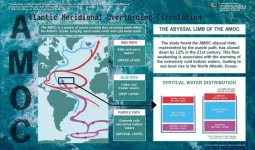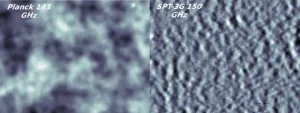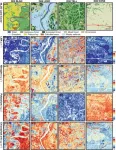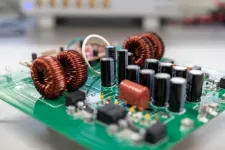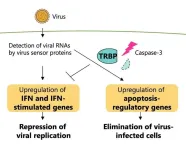(Press-News.org) PHILADELPHIA – Liver inflammation, a common side-effect of cancers elsewhere in the body, has long been associated with worse cancer outcomes and more recently associated with poor response to immunotherapy. Now, a team led by researchers from the Abramson Cancer Center and Perelman School of Medicine at the University of Pennsylvania has found a big reason why.
In their study, published today in Nature Immunology, the researchers discovered that cancer-induced liver inflammation causes liver cells to secrete proteins called serum amyloid A (SAA) proteins, which circulate through the body and hinder the ability of T cells—major anticancer weapons of the immune system—to infiltrate and attack tumors elsewhere.
“We want to better understand what causes cancer to resist or respond to immunotherapy to help design more effective strategies for patients,” said senior author Gregory Beatty, MD, PhD, an associate professor of Hematology-Oncology and the director of Clinical and Translational Research for the Penn Pancreatic Cancer Research Center. “Our findings show that liver cells—with their release of SAA proteins—effectively serve as an immune checkpoint regulating anti-cancer immunity, making them a promising therapeutic target.”
The study builds on previous research from the team, including co-lead authors Meredith Stone, PhD, a research associate, and Jesse Lee, a graduate student, into liver inflammation in cancer: In a 2019 study, they showed how it promotes pancreatic tumor metastasis to that organ. In 2021, researchers from the Beatty Laboratory observed that systemic inflammation, involving many of the same molecules implicated in liver metastasis, is associated with worse responses to immunotherapies in pancreatic cancer patients. The latest study was designed to investigate in more detail how liver inflammation may block the effects of these immune-boosting therapies.
First, they looked at mouse models of pancreatic cancer, measuring the amount of T-cell infiltration in pancreatic tumors—a basic indicator of anti-tumor immune activity. They found that mice with less T cell infiltration in their tumors tended to have more liver inflammation. These mice also showed stronger signs of an inflammatory signaling pathway called the IL-6/JAK/STAT3 pathway—the same one the team had implicated in liver metastasis in their 2019 study.
The researchers next showed that STAT3 activation in liver cells is associated with the reduced production of immune cells called dendritic cells, which are critical for normal T cell responses. When the scientists deleted STAT3 from liver cells, dendritic cell production and T cell activity picked up, and tumors that previously had only low T cell-infiltration developed high T cell-infiltration.
Ultimately the team found that STAT3 activation in liver cells has its dendritic cell- and T cell-suppressing effect by inducing the production of SAA proteins, which target receptors on immune cells. Deleting the SAA proteins had the same immune-restoring effect as deleting STAT3, and increased survival times and the likelihood of cures in mice that had pancreatic tumors surgically removed.
To get a sense whether the mouse model findings would translate to humans, the researchers measured SAA levels in tissue samples from patients whose pancreatic tumors had been surgically removed and found that those with low SAA levels at surgery went on to have significantly longer survival times afterward.
“The translational findings in human patients highlight the likely clinical relevance of our discoveries in the mice,” Beatty said. “Now that we’ve shown how liver inflammation puts up a roadblock to immunotherapy, our next step is to see if the same pathway can be targeted to reverse inflammation in patients who already have liver metastasis.”
The research team is now working to set up further preclinical and eventually clinical studies of STAT3- and/or SAA-inhibiting agents as potential add-on therapies in combination with immunotherapy—for example, prior to surgery—that could improve cancer patient outcomes.
Support for the research was provided by the National Institutes of Health (T32 CA009140, T32-HL007439-41, K12-CA076931-21, R01-CA197916, R01CA245323, U01 CA224193 and U01 CA224175), the Damon Runyon Cancer Research Foundation, the PacMen Consortium, the US Department of Defense (W81XWH2110622, W81XWH2110621), Stand Up to Cancer, the Robert L. Fine Cancer Research Foundation, the Penn-Wistar SPORE in Skin Cancer, AACR-The Mark Foundation for Cancer Research, and the Pancreatic Cancer Action Network.
###
Penn Medicine is one of the world’s leading academic medical centers, dedicated to the related missions of medical education, biomedical research, excellence in patient care, and community service. The organization consists of the University of Pennsylvania Health System and Penn’s Raymond and Ruth Perelman School of Medicine, founded in 1765 as the nation’s first medical school.
The Perelman School of Medicine is consistently among the nation's top recipients of funding from the National Institutes of Health, with $550 million awarded in the 2022 fiscal year. Home to a proud history of “firsts” in medicine, Penn Medicine teams have pioneered discoveries and innovations that have shaped modern medicine, including recent breakthroughs such as CAR T cell therapy for cancer and the mRNA technology used in COVID-19 vaccines.
The University of Pennsylvania Health System’s patient care facilities stretch from the Susquehanna River in Pennsylvania to the New Jersey shore. These include the Hospital of the University of Pennsylvania, Penn Presbyterian Medical Center, Chester County Hospital, Lancaster General Health, Penn Medicine Princeton Health, and Pennsylvania Hospital—the nation’s first hospital, founded in 1751. Additional facilities and enterprises include Good Shepherd Penn Partners, Penn Medicine at Home, Lancaster Behavioral Health Hospital, and Princeton House Behavioral Health, among others.
Penn Medicine is an $11.1 billion enterprise powered by more than 49,000 talented faculty and staff.
END
Analysis of mooring observations and hydrographic data suggest the Atlantic Meridional Overturning Circulation deep water limb in the North Atlantic has weakened. Two decades of continual observations provide a greater understanding of the Earth’s climate regulating system.
A new study published in the journal Nature Geoscience led by scientists at University of Miami Rosenstiel School of Marine, Atmospheric, and Earth Science, and the National Oceanic and Atmospheric Administration’s Atlantic ...
HOUSTON ― In a new study published today in Nature Biomedical Engineering, researchers at The University of Texas MD Anderson Cancer Center have designed a new method for developing immunotherapy drugs using engineered peptides to elicit a natural immune response inside the body.
In preclinical models of locally advanced and metastatic breast cancer, this method improved tumor control and prolonged survival, both as a monotherapy and in combination with immune checkpoint inhibitors.
“Amino acids are the building blocks of life and, when a few of them are linked together, they create a peptide. ...
Remember #BabyShark? And no, this was not the very catchy song for kids that took the internet by storm. Earlier this year, social media was abuzz with stunning footage of a newborn great white shark, captured by a flying drone.
Now, marine scientists have shown for the first time that juvenile great white sharks select warm and shallow waters to aggregate within one kilometer from the shore. These results, published in Frontiers in Marine Science, are important for conservation of great white sharks – especially as ocean temperatures increase due ...
When Kevin Ryan and the other hardworking volunteers at Mossom Creek Hatchery in Port Moody, B.C. release young coho smolts into the ocean, they’re never quite certain how many will return as adults.
Mossom releases between 5,000 and 10,000 coho smolts each year, and is one of the few hatcheries to release coho directly into the ocean, rather than into a river. Until now, no research had looked at the success of direct ocean releases of coho.
UBC researchers used acoustic telemetry to tag and track coho on their journey. The results were revealing: ...
Thanks to the dizzying growth of cosmic observations and measurement tools and some new advancements (primarily the “discovery” of what we call dark matter and dark energy) all against the backdrop of General Relativity, the early 2000s were a time when nothing seemed capable of challenging the advancement of our knowledge about the cosmos, its origins, and its future evolution.
Even though we were aware there was still much to uncover, the apparent agreement between our observations, calculations, and theoretical framework was indicating that our knowledge of the universe was set to grow significantly and without ...
An international team of researchers, led by Professor Jin WU from the School of Biological Sciences at The University of Hong Kong (HKU), has made a promising advancement in mapping plant functional traits from space using time-series satellite data. The study, published in Remote Sensing of Environment, showcases the innovative combination of the Sentinel-2 satellite mission and its dynamic time-series capabilities. This innovative approach not only unlocks a deeper understanding of essential foliar traits, providing crucial insights ...
The latest wearable devices, such as Samsung's Galaxy Ring and Apple's Vision Pro, are taking healthcare a step further and even enabling people to work virtually. Given the characteristics of wearable devices that require them to be small and lightweight, there is an inevitable limitation on battery capacity, still presenting a technical barrier to incorporating a variety of functions. In order for wearable devices to fully realize the imagined life, it is necessary to develop a lighter and more fromlessenergy storage method.
The Korea Institute of Science and Technology (KIST) announced that a joint research team led by Dr. Hyeonsu Jeong ...
Grocery stores, airports and beaches aren’t great places to have telehealth visits with your endocrinologist. But home can be one of the best locations, giving a doctor helpful insights into a patient’s home environment, which can positively impact their care.
This is just one finding shared in a new study published this week in The Journal of Clinical Diabetes.
Researchers interviewed clinicians and staff who provide diabetes care through telehealth across four University of California academic medical ...
A new DC-DC power converter is superior to previous designs and paves the way for more efficient, reliable and sustainable energy storage and conversion solutions. The Kobe University development can efficiently interface with a wide range of energy sources while enhancing system stability and simplicity at an unprecedented efficiency.
Electric power comes in two kinds, AC (alternating current) and DC (direct current). Famously, the question over which kind should be used for national power grids, the “Current War” of the late 19th century, got settled in favor of AC and most power plants today produce ...
Researchers have revealed the regulatory mechanism of a specific protein that plays a key role in balancing the immune response triggered by viral infections in mammal cells. These findings could help drive the development of antiviral therapies and nucleic acid medicines to treat genetic disorders.
For cells to protect themselves from viral infections, a series of immune responses typically occur, including programmed cell death called apoptosis and interferon signaling. While apoptosis is a normal process, which occurs with or without the presence ...
